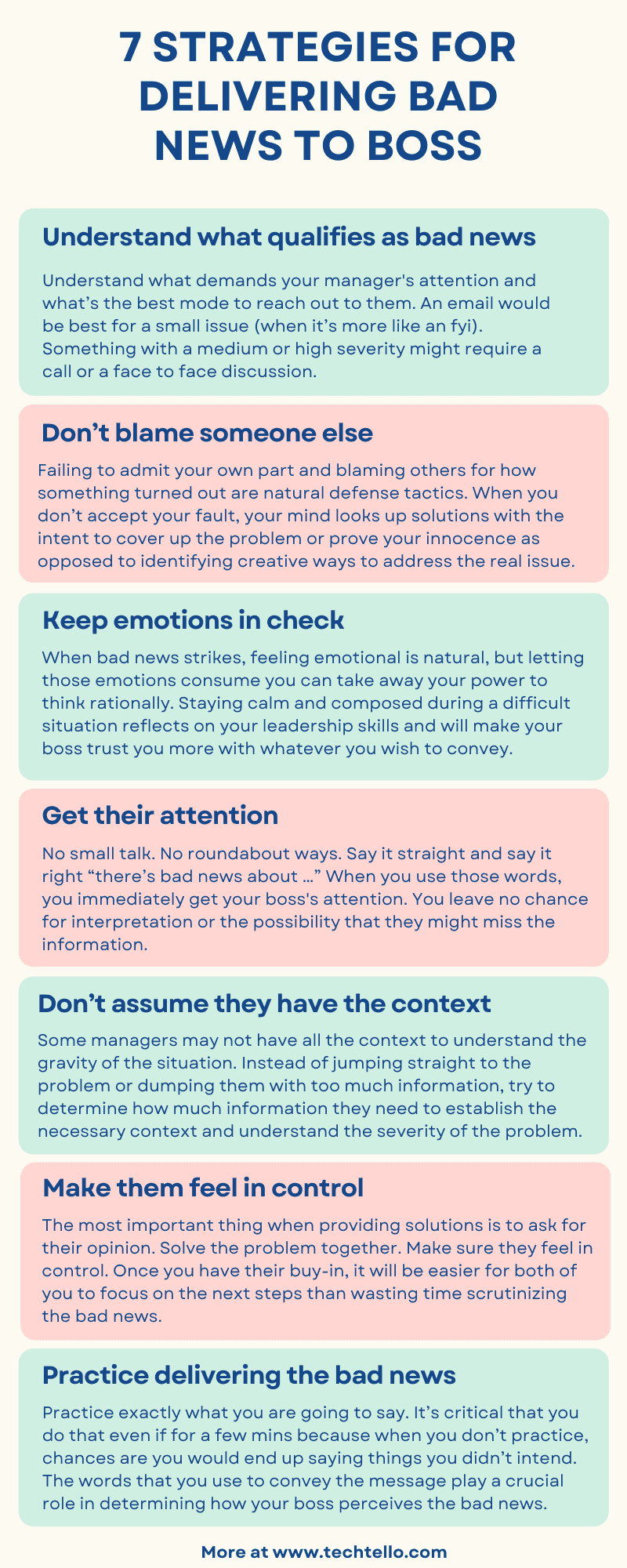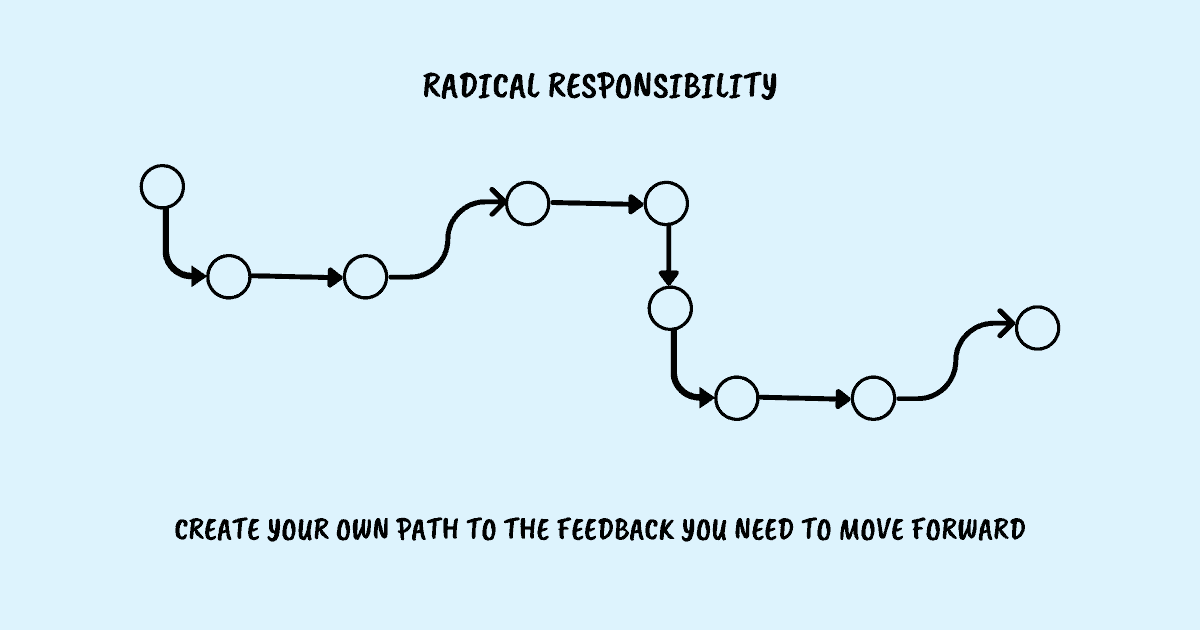7 Strategies for Delivering Bad News to Boss, Build Your Credibility and Still Look Good

Work won’t be fun if it’s just a straight line to where we need to go.
It’s the bumpy ride, ups and downs, twists and turns that make the entire experience more rewarding and fulfilling.
If we never make a mistake, how would we ever learn to separate right from wrong? If we never fail, how would we ever feel the high that comes with achieving success? If we never face a challenge, how would we learn to get past setbacks?
Disappointments, screw ups, unexpected outcomes, and bad news may create a sense of low for a while, but they are what push us to achieve the highs. They inspire us to do better. They create the thrill that comes with overcoming obstacles and turning them into opportunities.
Trying to avoid the bad news or pushing it under the rug with the hope that it will disappear on its own will only make it worse. The issue isn’t going to resolve itself. The delay will only add fuel to fire and make those who are impacted by it furious. And they will be right in feeling so. After all, by avoiding the very thing that demands all your attention at the critical moment, you convey that you can’t be trusted.
While announcing the bad news at the right time would have strengthened your relationship with people in the organization and given you an opportunity to show your leadership skills, avoiding it has quite the opposite effect. People start doubting your abilities. Some might even consider you incompetent. Others may show deep dissatisfaction with your immaturity.
Hiding the bad news from your boss will get you a lot of attention, exactly the kind of attention you were trying to avoid in the first place by not being forthright about the issues. Your boss and many others in the organization will eventually find out.
So next time, you have to deliver bad news to your boss and are tempted to delay, remember this: it’s in your own best interest and the interest of the organization that you step up, get over your fears and do the right thing. “When it comes to risky, controversial, and emotional conversations, skilled people find a way to get all relevant information (from themselves and others) out into the open,” writes Kerry Patterson in Crucial Conversations.
I understand that delivering bad news to your boss is not exactly fun. Imagining how they would react, what they would say, and how they would judge you can be terrifying and reason enough to try to cover it up. But knowing that with the right strategies you can turn things around and even win their trust and respect, you can get over your fears and take the necessary steps.
A better way to deliver bad news
Here are some of the strategies that have worked for me over the years and they will help you too once you shift your focus from “avoiding the bad news” to “start delivering results.”
1. Understand what qualifies as bad news and demands their attention
One big mistake we all make is this: not having enough understanding of what our bosses need to know, by when and how. What if your definition of urgent and bad does not match what they consider urgent and bad? You may end up bothering them with information they don’t care about or miss telling them the things that exactly need to be told.
Imagine pulling your boss from a meeting to convey your side of the bad story only to realize that your boss really doesn’t care about the issue as much and it definitely didn’t deserve an interruption during her meeting.
The attitude to leave everything to our managers and expect them to pull information without proactively pushing data is a source of a lot of miscommunication and bad decisions at work.
Start with taking a peek into your manager’s life. Ask them questions to understand what demands their attention, how much delay is acceptable in conveying bad news, and what’s the best mode to reach out to them. An email would be best for a small issue (when it’s more like an fyi). Something with a medium or high severity might require a call or a face to face discussion.
Setting up these expectations upfront with your manager will help you put your time and energy into solving issues when a bad situation presents itself as opposed to wondering if your boss needs to know about it.
2. Don’t blame or push someone else under the bus
Failing to admit your own part and blaming others for how something turned out are natural defense tactics, but they only shift your focus from attending to the bad news to playing a blame game.
When you don’t accept your fault, your mind looks up solutions with the intent to cover up the problem or prove your innocence as opposed to identifying creative ways to address the real issue.
“Blame is a prominent issue in many difficult conversations. Whether on the surface or below, the conversation revolves around the question of who is to blame. Who is the bad person in this relationship? Who made the mistake? Who should apologize? Who gets to be righteously indignant? Focusing on blame is a bad idea because it inhibits our ability to learn what’s really causing the problem and to do anything meaningful to correct it,” writes Douglas Stone in Difficult Conversations.
Don’t justify. Don’t give an excuse. State facts, not your assumptions or your opinions.
3. Keep emotions in check
When bad news strikes, feeling emotional is natural, but letting those emotions consume you can take away your power to think rationally. Staying calm and composed during a difficult situation reflects on your leadership skills and will make your boss trust you more with whatever you wish to convey.
It’s also important to watch out for your tone of voice – do you sound panicky, anxious, stressed out, charged with rage?
Observe your body language – is it negative conveying to your boss that you don’t feel in control? Speaking too fast, moving front and back, sweaty forehead, and fidgeting convey a lack of confidence, makes the other person feel anxious and turns a bad situation into an even worse one.
Amy Cuddy provides this powerful idea in Presence that you must keep in mind while conveying bad news to your boss “When our body language is confident and open, other people respond in kind, unconsciously reinforcing not only their perception of us but also our perception of ourselves.”
4. Get their attention
No small talk. No roundabout ways. Say it straight and say it right “there’s bad news about …”
When you use those words, you immediately get your boss’s attention. You leave no chance for interpretation or the possibility that they might miss the information.
Once you have their attention, they will be interested in what you have to say.
5. Don’t assume they have the context
Some managers are not involved in day-to-day operations and may not have all the context to understand the gravity of the situation when you have bad news to share. Think about:
Have they been in touch with the work you are doing recently?
What kind of questions have they asked related to this particular line of work in the past?
Instead of jumping straight to the problem or dumping them with too much information, try to determine how much information they need to establish the necessary context and understand the severity of the problem.
Once the context is established, then state your understanding of why the bad thing happened. Clarity and brevity is the key here.
6. Make them feel in control
Your boss definitely wants to know the problem, but they would want to hear some solutions too. So, be prepared to offer a few solutions with just enough data to help them understand why one solution might be better than the other.
The most important thing when providing solutions is to ask for their opinion. Solve the problem together. Make sure they feel in control. Once you have their buy-in, it will be easier for both of you to focus on the next steps than wasting time scrutinizing the bad news. You can do that later once the situation is under control and you have more time at your hands to understand how such situations can be mitigated in the future.
7. Practice delivering the bad news
Practice exactly what you are going to say. It’s critical that you do that even if for a few mins because when you don’t practice, chances are you would end up saying things you didn’t intend. The words that you use to convey the message play a crucial role in determining how your boss perceives the bad news.
For example instead of saying “I have no idea how this happened. We tried our best to keep the client happy with our services. But today they decided to end the contract and choose another partner,” say “I have bad news. One of our clients [client name] decided to end our contract today. I have spent some time trying to understand what could have gone wrong. I think the reason they don’t want to continue is [some reason]. I am planning to have another call with them to see if we can still turn this around and change their decision. I have 3 strategies that I wanted to discuss with you – strategy A, strategy B, and strategy C. I think strategy B is more promising because…What do you suggest?”
By carefully planning what you intend to say, you won’t have to regret your poor choice of words later. For example, you won’t end up blaming someone else for the bad news or sharing information that doesn’t add up. You can also think about some of the follow-up questions they might ask and spend time rehearsing them as well. Doing this whole activity won’t take more than a few minutes and it will be worth your time. Being well prepared to deliver bad news to your boss in this manner will showcase your ability to handle difficult situations and build further trust with your manager.
Summary
- Delaying or avoiding bad news hurts your credibility. When you don’t own up to difficult situations and take steps to set things right, others don’t trust you and without trust, you cannot succeed at work.
- By reframing bad news from a “thing to be avoided” to an “opportunity to reach for your potential,” you can take constructive action to set things right thereby building new skills and establishing your competence.
- The first step starts even before you encounter the bad news. Take time to understand what qualifies as bad news and demands your manager’s time and attention. Also, establish the best mode (email, phone, face-to-face) to reach out to them.
- Keep away from anything that leads to finger-pointing and blame games. Take responsibility and show them that you have what it takes to set things right.
- Take control of your emotions by staying calm and composed so that your manager can focus on the problem and the solution and not have to deal with your emotion. Being too emotional will also prevent you from thinking rationally.
- Start with being upfront by conveying that you have bad news to share. Once you have their attention, you can be more effective in putting your message across.
- Clarity of communication and brevity is the key to conveying bad news. Establish necessary context and then present a view of why the bad situation happened.
- Don’t just provide solutions, ask for their opinion. Make them feel in control. A feeling of control will enable them to creatively problem-solve this with you.
- Finally, don’t just rush to deliver bad news. Take a moment to practice the words you are going to speak. Without practicing, you may end up saying things you will regret later.






























